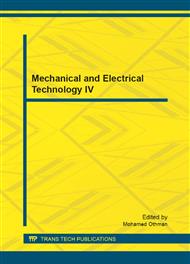[1]
Lagoudas DC,Entchev PB. Modeling of transformation-induced plasticity and its effect on the behavior of porous shape memory alloys. Part I: Constitutive model for fully dense SMAs[J]. Mechanics of Materials. 2004, 36: 865-896.
DOI: 10.1016/j.mechmat.2003.08.006
Google Scholar
[2]
Lagoudas DC,Entchev PB et al. Shape memory alloys, Part II: Modeling of polycrystals[J]. Mechanics of Materials, 2006, 38(5-6): 430-462.
DOI: 10.1016/j.mechmat.2005.08.003
Google Scholar
[3]
Lexcellent C, Leclerq S, Gabry B, Bourbon G. The two way shape memory effect of shape memory alloys: an experimental study and a phenomenological mode Interational[J]. Journal of Plasticity, 2000, 16: 1155-1168.
DOI: 10.1016/s0749-6419(00)00005-x
Google Scholar
[4]
Boubakar. ML, Moyne S, Lexcellent C. SMA pseudoelastic finite strains:theroy and numerical application[J]. Journal of Engineering Materials and Technology. 1999, 121: 44-45.
DOI: 10.1115/1.2815998
Google Scholar
[5]
Moyne S,Boubakar ML,Lexcellent C. Extension of a Linear Behaviour Model of Shape Memory Alloys for Finite Strain Studies[J] Journal of physics, 1997 5:83-88.
DOI: 10.1051/jp4:1997513
Google Scholar
[6]
Lexellent C, Boubakar ML, Bouvet C, Calloch S. About modeling the shape memory alloy behaviour based on the phase transformation surface identification under proportional loading and anisothermal conditions[J]. International Journal of Solids and Structures, 2006, 43: 613-626.
DOI: 10.1016/j.ijsolstr.2005.07.004
Google Scholar
[7]
Qidwai MA, Lagoudas DC. On thermomechanics and transformation surfaces of poly-crystalline NiTi shape memory alloy material[J]. Interational Journal of Plasticity, 2000, 16: 1309-1343.
DOI: 10.1016/s0749-6419(00)00012-7
Google Scholar
[8]
Auricchio F, Taylor RL. Shape-memory alloys: modeling and numerical simulations of the finite-strain superelastic behavior[J]. Computer Methods in Applied Mechanics and Engineering. 1997, 143: 175-194.
DOI: 10.1016/s0045-7825(96)01147-4
Google Scholar
[9]
Auricchio F, Taylor RL. Lublincr J. Shape-memory alloys: macromodelling and numerical simulations of the superelastic behavior[J]. Computer Methods in Applied Mechanics and Engineering. 1997, 146: 281-312.
DOI: 10.1016/s0045-7825(96)01232-7
Google Scholar
[10]
Auricchio F. A robust integrationalorithm for a finite-strain shape memory alloy superelastic model[J]. International Journal of Plasticity. 2001, 17: 971-990.
DOI: 10.1016/s0749-6419(00)00050-4
Google Scholar
[11]
Auricchio F, Beirão L, DaVeiga, Lovadina C, Reali A. The importance of the exact satisfaction of the incompressibility constraint in nonlinear elasticity: mixed FEMs versus NURBS-based approximations[J]. Computer Methods in Applied Mechanics and Engineering, 2010, 199: 314-323.
DOI: 10.1016/j.cma.2008.06.004
Google Scholar
[12]
Helm,Stress computation in finite thermoviscoplasticity[J], International Journal of Plasticity, 2006, 22: 1699-1727.
DOI: 10.1016/j.ijplas.2006.02.007
Google Scholar
[13]
Helm D, Haupt P. Shape memory behaviour: modelling within continuum thermomechanics[J]. International Journal of solids and Structures, 2003, 40: 827-849.
DOI: 10.1016/s0020-7683(02)00621-2
Google Scholar
[14]
Christ D, Reese S. Finite element modeling of shape memory alloys-A comparison between small-strain and large-strain formulations[J]. Materials Science and Engineering A, 2008, 481-482: 343-346.
DOI: 10.1016/j.msea.2006.11.174
Google Scholar
[15]
Reese S, Christ D. Finite deformation pseudoelasticity of shape memory alloys Constitutive modeling and finite element implementation[J]. International Journal of Plasticity. 2008, 24: 455-482.
DOI: 10.1016/j.ijplas.2007.05.005
Google Scholar
[16]
Christ D, Reese S A finite element model for shape memory alloys considering thermomechanial couplings at large strains[J]. International Journal of solids and Structures. 2009, 46: 3694-3709.
DOI: 10.1016/j.ijsolstr.2009.06.017
Google Scholar
[17]
Raniecki B, Lexcellent C, Tanaka K. Thermodynamic models of pseudoelastic behaviour of shape memory alloys[J]. Archives of Mechanics. 1992, 44(3): 261-284.
Google Scholar
[18]
Tanakz K A phenomenological description on thermomechanical behavior of shape memory alloys[J]. International Journal of Pressure Vessels and technology. 1990, 112: 158-163.
DOI: 10.1115/1.2928602
Google Scholar
[19]
Zhu Yuping, Some Studies on Constitutive Model of Shape Memory Alloy[D]. p.12(in Chinese).
Google Scholar


